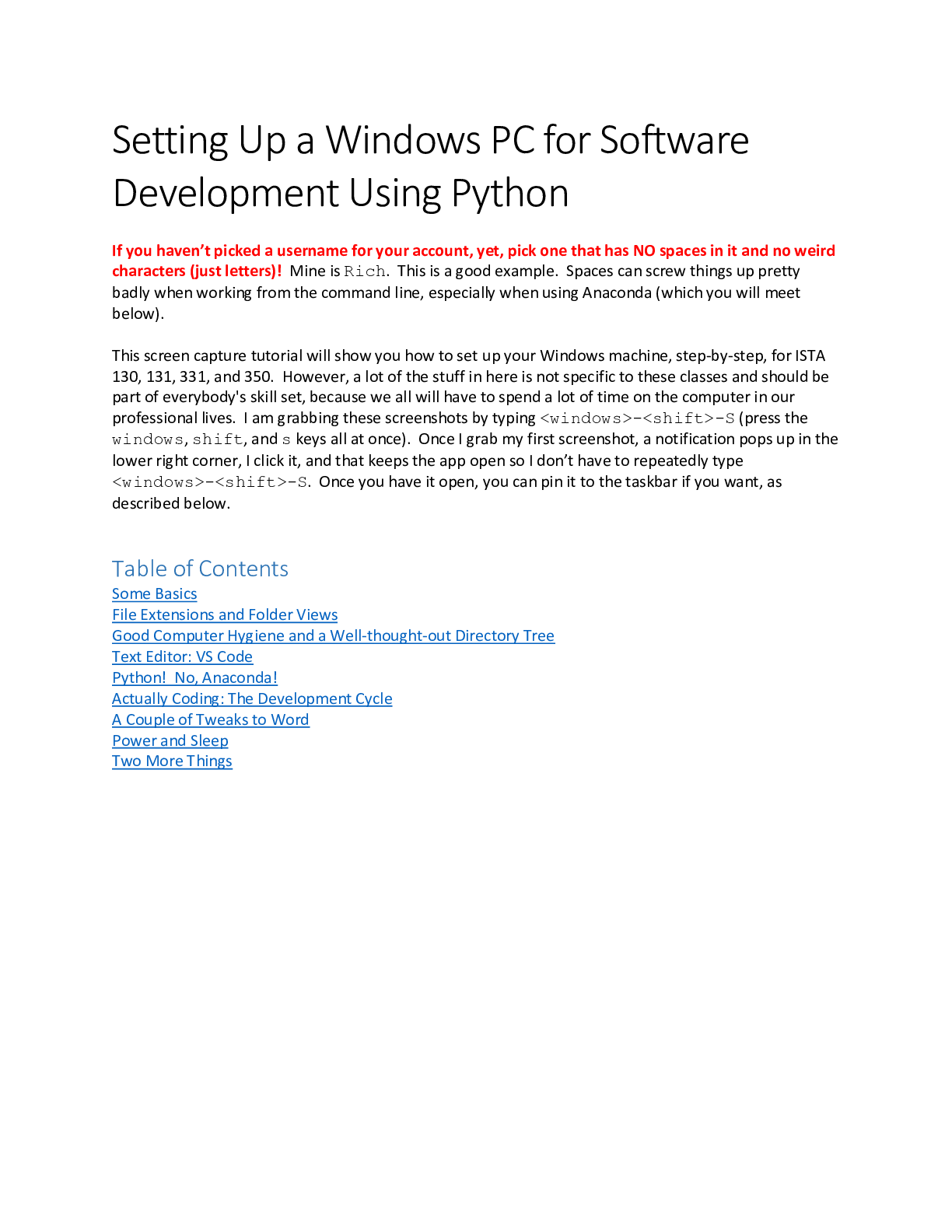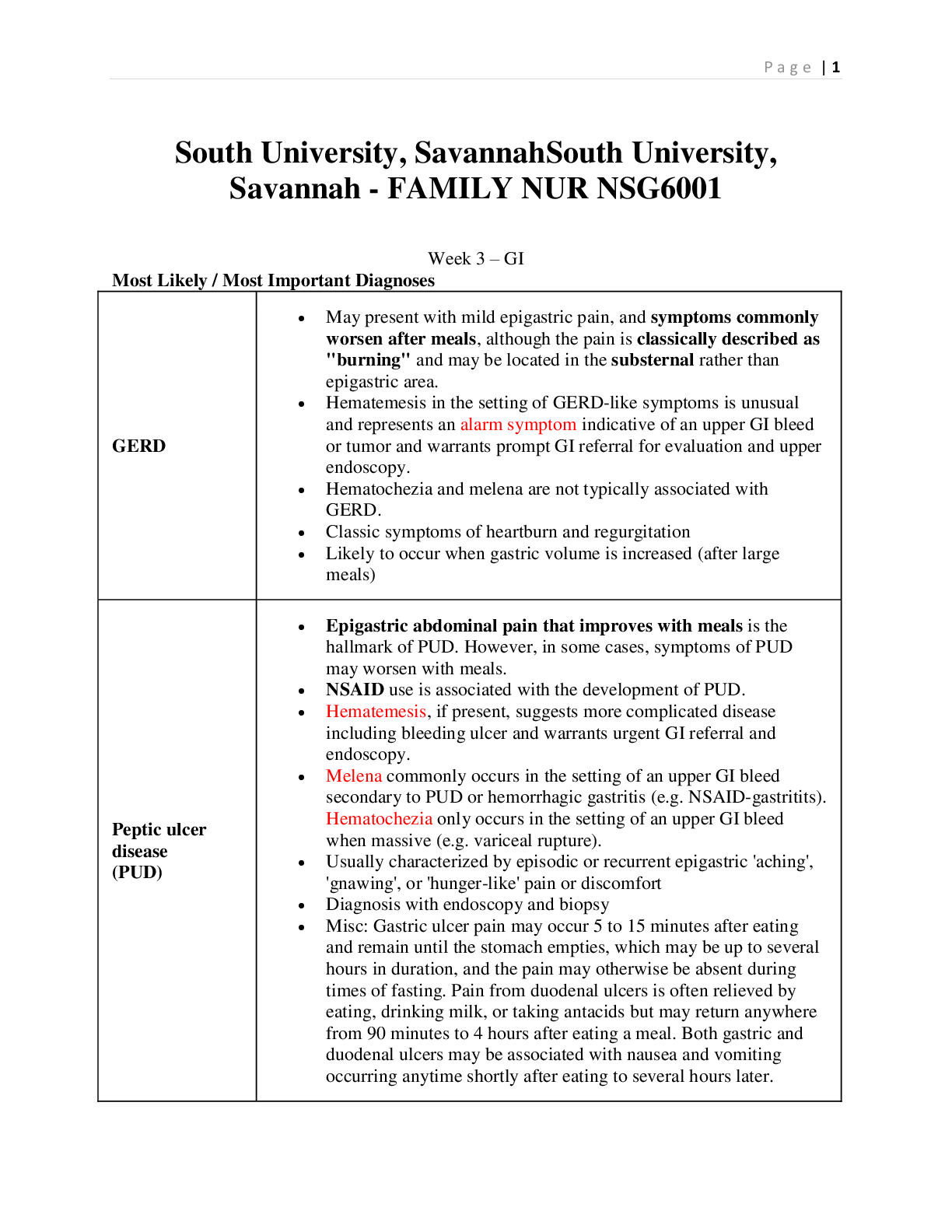*NURSING > Class Notes > NR508 Midterm Outline Complete (All)
NR508 Midterm Outline Complete
Document Content and Description Below
NR508 Midterm Outline Midterm Outline Chapter 1: The Role of the Advanced Practice Nurse as Prescriber Roles and responsibilities of APRN prescribers Clinical judgement in Prescribing Collaborati... on with other providers Autonomy and Prescriptive authority Chapter 2: Review of Basic Principles of Pharmacology Metabolism: Metabolism & Half Life Drug Responses Receptors: agonists, antagonists Pharmacokinetics: Absorption, Distribution, Protein Binding, Metabolism (including firstpass and Phase I and II) Cytochrome P450 metabolism Excretion: Renal, Biliary, Other (eg for volatile drugs) Chapter 3: Rational Drug Selection Process of rational drug prescribing: 6 Steps proposed by WHO: Define the patient's problem Specify the therapeutic objective Collaborate with the patient Choose the treatment Educate the patient Monitor effectiveness Patient education Poor adherence contributes to worsening disease, hospital admissions and death Patient education should be at the 5th or 6th grade level Include in education: Purpose of medication Instructions for administration Adverse drug reactionsMonitor effectiveness Passive monitoring: patient is educated on expected outcome and instructed to contact provider Active monitoring: follow up laboratory tests or monitoring to measure therapeutic effectiveness Drug, Patient, and Provider factors that influence drug selection DRUG:Pharmacokinetic factors Pharmacodynamics factors Therapeutic factors Safety Cost Patient factors Provider factors Alternative therapies PATIENT: Previous adverse drug reactions Health beliefs Current drug therapy Drug interactions Consult PharmD regarding complex drug regimens Patient age Pregnancy PROVIDER: Ease of prescribing or monitoring Formularies NPs need to be familiar with the formulary they are allowed to prescribe Personal formulary: each provider develops a small list of drugs they are comfortable prescribing Influences on Rational Prescribing: Pharmaceutical Promotion Pharmaceutical promotion May influence prescribing When Prescribing Recommendations Change When guidelines change, providers may need to be coached or reeducated regarding appropriate prescribing Chapter 4: Legal and Professional Issues in Prescribing New Drug Approval process including Clinical Phases U.S. FDA Regulatory Jurisdiction: official labelling vs off-label use of drugs Chapter 5: Adverse Drug Reactions Mechanistic Classification of ADRs including Types of Immune-Mediated ADRs and Types A-F Common Causes of ADRs: Risk Factors, including common drugs involved and which cause skin reactionsTime-Related Classification of ADRs including drugs associated with withdrawal symptoms Dose-Related ADRs classification Chapter 6: Factors that Foster Positive Outcomes Overview of nonadherence Keys to effective patient education Health and Cultural beliefs Health Literacy Complexity of Drug Regimen and Polypharmacy Simplifying the Regimen Communication Difficulties Chapter 9: Nutrition and Nutraceuticals Nutrient-Drug Interactions (eg warfarin and vit K) Influence of Diet on Pharmacokinetics of Drugs: Drug absorption Drug Metabolism Grapefruit juice and CYP3A4 Cruciferous foods and CYP1A2 Drug Excretion Drug -Induced Nutrient Depletion (eg folate and B12) Outcomes of Nutrient-Drug Interactions Nutritional Management: Table 9-2 Recommended vitamins for the following special populations: infants and children; women of child bearing age; pregnant women vegans, older adults; those not exposed to sunlight or with dark skin; alcoholics; patients taking isoniazid (INH) Nutraceuticals: Vitamin that is teratogenic in excessive amounts, Vitamin that is useful for migraine prophylaxisChapter 12: Pharmacoeconomics Know what Pharmacoeconomics is Impact of Cost: Direct and Indirect Chapter 13: Over-the-counter Medications OTC Medication characteristics and regulation OTC Medication Sales Hazards of OTC Self-Medication Adverse Effects of OTC Self-Medication Drug Interactions: antacids, anticholinergics, CNS Depressants, NSAIDS and ASA Abuse of OTC Medications: Combat Methamphetamine Epidemic Act Patient Education Regarding OTC Medications Chapter 14 Drugs Affecting the Autonomic Nervous System Pharmacodynamics of Alpha2 Agonists Pharmacodynamics of Beta Blockers, adverse effects, what happens with abrupt withdrawal of Beta Blockers? Pharmacokinetics: Beta blockers Phamacotherapeutics: precautions and Contraindications of beta blockers Adverse Drug Reactions Clinical Uses and Dosing of Beta Blockers Muscarinic Agonists: Pharmacodynamics, MOA, treatment uses, Chapter 15 Drugs Affecting the Central Nervous System Anorexiiants: Precautions and Contraindications, Iminostilbenes: Metabolism and Excretion, MOAs, indications, absolute contraindications, precautions, monitoring, adverse drug reactions, drug interactions, Black Box warnings,What does Long Term monitoring consist of with Iminostilbenes? Succinimides: MOA, Monitoring Drugs That Affect GABA: Monitoring, ADR’s, Pharmacotherapeutics: Precautions and Contraindications, Patient Education, Drug interactions(Lamotrigine) Tricyclic Antidepressants (TCA): Precautions and Contradictions, Monoamine Oxidase Inhibitors(MAOIs): drug interactions Table15-13, Food and drug interations. SSRI: Adverse Drug Reactions, management in children, Drug interactions (including herbals & supplement), Patient Education Chapter 28 Chronic Stable Angina and Low Risk Unstable Angina Additional Patient Variables: Concomitant Diseases Beta Blocker-diabetes Mellitus Chapter 36: Heart Failure Indications for heart failure drugs by stage First line drugs of choice for heart failure MOA of ACEIs that benefit heart failure Indications for use of BBs in patients with heart failure Drugs that increase life expectancy in patients with heart failure Digoxin indications and adverse reactions Drugs contraindicated in heart failure Drugs for managing heart failure during pregnancy Patient monitoring of HF Indications to use anticoagulant therapy Patient educationChapter 40 Hypertension Classes of drugs used and their MOAs: Nitrates, BBs, CCBs, ACEIs, What drugs increase myocardial oxygen supply Causes of hypertension Which drugs treat hypertension & BPH, MI, Heart Failure African Americans. [Show More]
Last updated: 2 years ago
Preview 1 out of 6 pages
.png)
Buy this document to get the full access instantly
Instant Download Access after purchase
Buy NowInstant download
We Accept:

Reviews( 0 )
$5.00
Can't find what you want? Try our AI powered Search
Document information
Connected school, study & course
About the document
Uploaded On
May 15, 2021
Number of pages
6
Written in
Additional information
This document has been written for:
Uploaded
May 15, 2021
Downloads
0
Views
70























